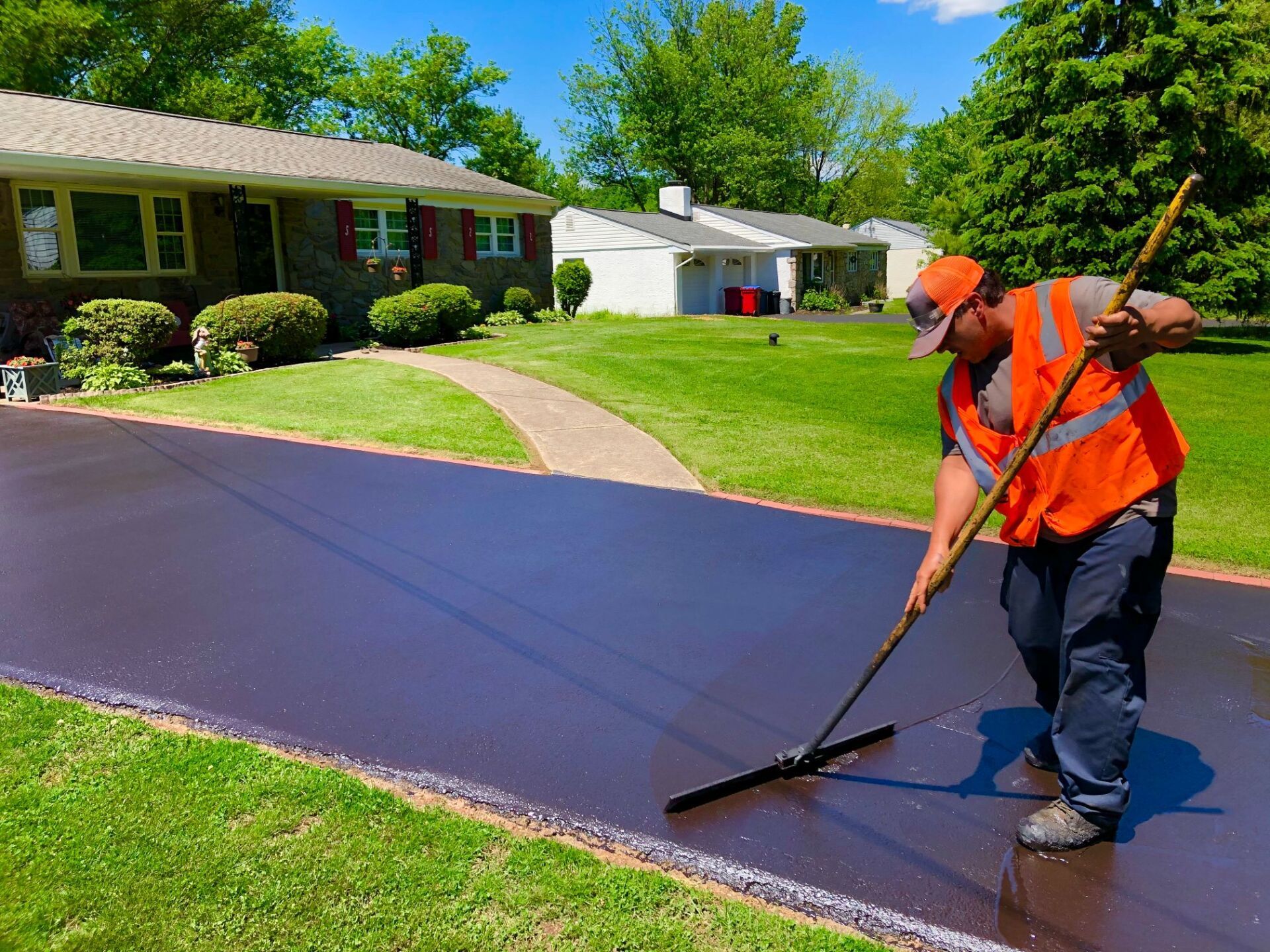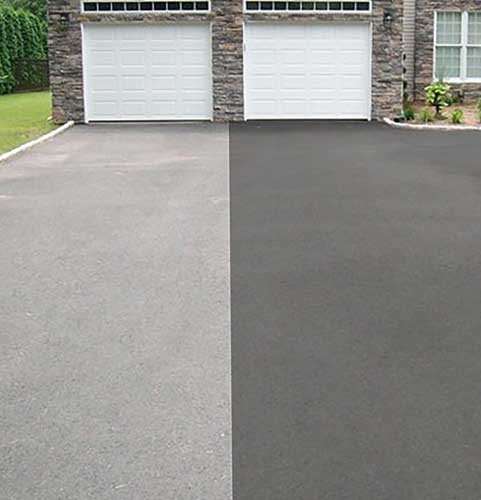Mastering Angled Parking: How Asphalt Sealing Improves Business Whole Lots
Wiki Article
Warm Mix Asphalt: A Lasting Remedy for Sidewalk
Hot Mix Asphalt (HMA) has emerged as a leading sustainable choice for pavement options, using a myriad of innovative technologies and ecological advantages. Its capacity to reuse materials and reduce power intake offers an engaging situation for its adoption in road building jobs. The long-term efficiency and sturdiness of HMA make it a recommended choice for infrastructure growth. As the need for environment-friendly building and construction methods grows, exploring the subtleties of HMA's sustainability can give beneficial understandings into the future of pavement remedies.Environmental Advantages of Hot Mix Asphalt

Furthermore, Hot Mix Asphalt aids to reduce city heat island results. Its dark shade soaks up sunlight, reducing the amount of warm reflected back right into the atmosphere compared to lighter-colored sidewalks. This can lower ambient temperature levels in metropolitan locations, decreasing the need for cooling and eventually lowering energy intake.
Additionally, Warm Mix Asphalt adds to enhanced stormwater monitoring. Its permeable nature permits water to charge and penetrate the pavement groundwater materials, lowering runoff and the risk of flooding. These environmental benefits make Warm Mix Asphalt a lasting selection for leading roadways and freeways.
Power Efficiency in HMA Production
Is energy efficiency a critical element in the manufacturing of Hot Mix Asphalt (HMA)? Absolutely. Energy plays a considerable duty in the production of HMA, impacting both cost and environmental sustainability. One key facet of energy efficiency in HMA production is the use of cozy mix asphalt (WMA) modern technologies (angled parking). WMA enables the blending and positioning of asphalt at lower temperatures contrasted to conventional hot mix asphalt, causing lowered power usage during manufacturing. This procedure not only decreases fuel use however also lowers greenhouse gas emissions, making it an extra eco-friendly choice.Furthermore, advancements in plant technologies have led to even more energy-efficient HMA production processes. By optimizing energy use in HMA manufacturing, the industry can decrease its carbon impact while preserving high-grade pavement materials.
Recyclability of Warm Mix Asphalt
The recyclability of Warm Mix Asphalt (HMA) is a critical facet of its sustainability and long-term environmental effect. HMA is just one of one of the most recycled materials in the USA, with over 100 million loads of recovered asphalt sidewalk (RAP) being recycled each year in brand-new sidewalk building and construction. Reusing HMA uses numerous ecological benefits, such as decreasing the requirement for virgin products, decreasing power intake throughout production, and lowering the amount of waste sent to check my reference land fills.The process of recycling HMA involves milling the existing pavement, crushing it right into smaller sized items, and blending it with brand-new accumulation and asphalt binder to produce a recycled mix. This recycled mix can frequently carry out in addition to and even much better than traditional HMA, while calling for fewer basic materials and producing lower greenhouse gas emissions. By incorporating RAP into brand-new pavement jobs, road agencies can conserve natural resources, decrease costs, and reduce the environmental impact of road construction and maintenance tasks. On the whole, the recyclability of HMA plays a significant duty in promoting lasting methods within the pavement sector.

Long-Term Performance of HMA
Asphalt pavements demonstrate toughness and durability over an extensive duration, mirroring the lasting efficiency of Warm Mix Asphalt (HMA) The longevity of HMA can be attributed to its ability to withstand rush hour loads, severe climate condition, and the results of aging. Research studies have actually revealed that properly designed and properly created HMA sidewalks can last for two decades or even more with routine upkeep. The trick to taking full advantage of the long-lasting performance of HMA depends on making use of top quality materials, following ideal techniques in building and construction, and carrying out effective upkeep methods. Appropriate drainage, regular assessments, and timely repair services are necessary for protecting the structural honesty of HMA pavements over time. Additionally, developments in HMA technology, such as using polymer-modified binders and warm mix asphalt, have better improved the durability and longevity of HMA sidewalks. By focusing on quality building and construction and maintenance practices, HMA continues useful link to show itself as a sustainable and cost-efficient option for resilient pavement facilities.
HMA: Longevity and Sustainability
Showing both toughness and sustainability, Hot Mix Asphalt (HMA) has actually ended up being a keystone in the building of resilient pavement frameworks - angled parking. HMA's durability comes from its ability to stand up to hefty tons, rough climate condition, and high web traffic quantities, making it a trusted option for highways, freeways, and flight terminal paths. The make-up of HMA, which typically includes accumulations, binder, and filler, plays an essential role in enhancing its longevity and resistance to damage
Furthermore, HMA's sustainability depends on its recyclability and energy-efficient production procedure. The capacity to reuse recovered asphalt sidewalk (RAP) in brand-new HMA mixes minimizes the demand for virgin products and minimizes the environmental effect of sidewalk construction and maintenance. In addition, the energy effectiveness of creating HMA hinges on its lower mixing temperatures contrasted to various other pavement materials, causing reduced energy usage and greenhouse gas emissions.
Final Thought
To conclude, warm mix asphalt (HMA) supplies a sustainable option for sidewalk with its eco-friendly characteristics. HMA's recyclability, energy efficiency in production, and lasting sturdiness make it an eco-friendly choice for road construction. By conserving natural deposits, minimizing waste, and reducing greenhouse gas discharges, HMA plays a vital function in promoting sustainability in facilities development. Its capability to alleviate metropolitan warm island effects even more underscores its significance in producing durable and ecologically mindful sidewalk systems.
HMA is one of the most recycled materials in the United States, with over 100 million bunches of recovered asphalt pavement (RAP) being recycled each year in new sidewalk building.The process of reusing HMA involves grating the existing pavement, squashing it into smaller sized pieces, and blending it with new aggregate and asphalt binder to create a knockout post a recycled mix.Asphalt pavements show longevity and durability over an extensive period, reflecting the long-term efficiency of Hot Mix Asphalt (HMA) Furthermore, advancements in HMA modern technology, such as the use of polymer-modified binders and cozy mix asphalt, have actually additionally boosted the toughness and longevity of HMA pavements. The capacity to reuse redeemed asphalt pavement (RAP) in new HMA combinations decreases the need for virgin materials and reduces the environmental influence of pavement building and upkeep.
Report this wiki page